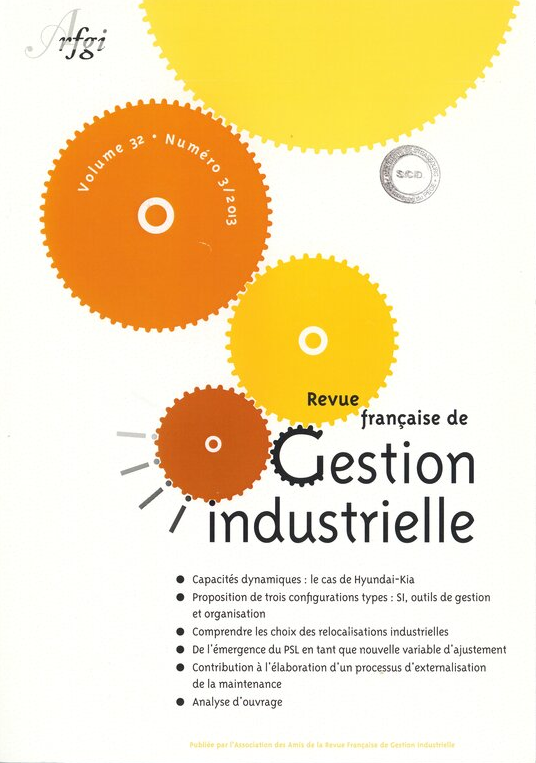Capacités dynamiques : le cas de hyundai-kia
DOI :
https://doi.org/10.53102/2013.32.03.700Mots-clés :
Intention Stratégique, Capacités Dynamiques, Industrie Automobile, HyundaiRésumé
Cet article cherche a montrer l'interet de la theorie des capacites dynamiques pour analyser la mise en oeuvre de 2000 a 2010 d'une strategie de croissance d'un constructeur automobile : Hyundai-Kia. Partant d'une intention strategique formulee en 2000, les dirigeants de cette entreprise ont deploye des ressources et des competences en particulier en termes de production d'automobiles a bas cats. Conjointement, l'entreprise a effectue des depenses importantes pour ameliorer la qualite de ses produits et repondre aux attentes des clients dans les differentes regions du monde. Une dynamique rigoureuse a ete mise en oeuvre pendant dix ans faisant aujourd'hui de ce groupe le cinquieme constructeur mondial. La theorie des capacites dynamiques permet de comprendre le deploiement structure de la strategie d'une organisation.
Références
Ambrosini, V., Bowman, C., (2009), « What are Dynamic Capabilities and are they a Useful Construct in
Strategic Management? », International Journal of Management Reviews, 11(1): 29-49.
Aragon-Correa, J. A.,.Sharma, S., (2003), 0 A contingent resource-based view of proactive corporate environmental strategy», Academy of Management Review, 28(1): 71- 88.
Barney, J., (1991), « Firm Resources and Sustained Competitive Advantage », Journal of Management, 17(1).
Brink, J., Holmen, M., (2006), « Capabilities and Radical Changes of the Business Models of New
Bioscience Firms », Creativity and Innovation Management, vol.18, n° 2, p. 109-120, 2009.
Byoung-Hoon, L., Hyung-Je, J., (2007), « The Mutation of the Toyota Production System: Adapting the TPS at Hyundai Motor Company », International Journal of Production Research, vol. 45, n° 16, p. 3665-3679.
Collis, D. J., (1994), « Research note: How valuable are organizational capabilities? » Strategic Management Journa1,15 (Winter special issue), p. 143-152.
Cohen, W.M., Levinthal, D.A., (1990), « Absorptive Capacity: A New Perspective on Learning and Innovation », Administrative Science Quarterly, vol. 35, n° 1, p. 128-152.
Danneels, E., (2002), « The dynamics of product innovation and firm competences », Strategic Management Journal, 23,1095-1121
Dierickx, I., Cool, K., (1989), 0 Asset Stock Accumulation and Sustainability of competitive Advantage », Management Science, 35, (12), pp. 1504-1511.
Easterby-Smith, M., Lyles, M. A., Peteraf M., (2009), « Dynamic Capabilities: Current Debates and Future Directions », British Journal of Management, 20: 51-88.
Eisenhardt, K. M., Martin, J. A., (2000), « Dynamic Capabilities: What Are They? », Strategic Management Journal, 21(10/11): 1105-1121.
Hamel, G., Prahalad C. K.,(1990), « The core competencies of the corporation », Harvard Business Review, vol. 68,3.
Hamel, G., Prahalad C. K., (1989), « Strategic Intent », Harvard Business Review, vol. 67,3.
Helfat, C. E,. Peteraf, M,. (2009), « Understanding dynamic capabilities: progress along a developmental path », Strategic Organization, 7(1): 91-102.
Hofer C., Schendel D. , (1978), Strategy formulation : analytical concepts, West Publishing Company.
Helfat, C.E., (1997), 0 Know-how and asset complementarity and dynamic capability accumulation: the case of R&D », Strategic Management Journal, 18,339-360.
Karim, S., (2006), « Modularity in organizational structure: the reconfiguration of internally developed and acquired business units », Strategic Management Journal, 27,799-823.
Karim, S., Mitchell, W. ,(2000), « Path dependent and path-breaking change: reconfiguring business resources following acquisitions in the U.S. medical sector, 1978-1995 )), Strategic Management Journal, 21,1061-1081.
Lee B.-H., Jo, H.-J., (2007), « The Mutation of the Toyota Production System: Adapting the TPS at Hyundai Motor Company » International Journal of Production Research , 45,16: 3665-3679.
Loasby, B. J., (2010), « Capabilities and strategy: problems and prospects », Industrial and Corporate Change, 19(4).
Madhoc, A., Osegowisch, T., (2000), « The international biotechnology industry: a dynamic capabilities perspective », Journal of International Business Studies, 31,325-335.
Mintzberg H., Ahlstrand B., Lampel J., (1998), Strategy safari, NewYork, The Free Press.
Partin, F., (2006), « L'internationalisation : un defi pour les competences de l' equipe dirigeante d'une PME », Gestion, vol. 31, n° 1,
Moliterno, T., Wiersema, M.F., (2007), « Firm performance, rent appropriation, and the strategic resource divestment capability », Strategic Management Journal, 28,1065-1087.
Pavlou, P. A., El Sawy, 0. A., (2011), 0 Understanding the Elusive Black Box of Dynamic Capabilities », Decision Sciences, 42(1): 239-273.
Penrose, E. G., (1959), The Theory of the Growth of the Firm, Wiley, New York.
Peteraf, M. A., (1993), « The cornerstones of competitive advantage: a resource based view », Strategic Management Journal, vol. 14, p. 179-191.
Priem, R., Butler, J., (2001). « Is the resource-based 'view' a useful perspective for strategic management research? », Academy of Management Review, 26,22-40.
Saias M., Metais, E., (2001), « Strategie d'entreprise : evolution de la pens& », Finance Controle Strategie, Volume 4, N° 1, p. 183-213, mars
Teece, D.J., Pisano G., Shuen A., (1997), « Dynamic Capabilities and Strategic Management », Strategic Management Journal, vol. 18:7, August, pp.509-533.
Teece, D. J., (2007), 0 Explicating Dynamic Capabilities: the Nature and Microfoundations of (sustainable) enterprise performance », Strategic Management Journal, 28: 1319-1350.
Tripsas, M., Gavetti, G., (2000), « Capabilities, cognition, and inertia: evidence from digital imaging », Strategic Management Journal, 21,1147-1161.
Wang, C., Ahmed, P., (2007), 0 Dynamic capabilities: a review and research agenda », International Journal of Management Review, 9,31-51.
Winter, S., (2003), « Understanding dynamic capabilities », Strategic Management Journal, 24,991-995.
Yin, R. K., (2003), 0 Case Study Research: Design and Methods », Thousand Oaks, CA: Sage Publications (3rd ed.).
Zahra S.A., Sapienza H.J., Davidson P. (2006), « Entrepreneurship and Dynamic Capabilities: A review, model and research agenda », Journal of Management Studies, 43(4): 917-955.
Zahra, S.A., George, G., (2002), 0 Absorptive capacity: a review, reconceptualization and extension », Academy of Management Review, 27,185-203.
Zander, U., Kogut B., (1995). 0 Knowledge and the speed of the transfer and imitation of organizational capabilities », Organization Science, 6(1), pp. 76-92.
Zollo, M., Winter, S. G., (2002), « Deliberate Learning and the Evolution of Dynamic Capabilities », Organization Science, 13(3): 339-351.
Numéro
Comment citer
Rubrique
Licence
(c) Tous droits réservés RFGI 2021

Ce travail est disponible sous licence Creative Commons Attribution - Pas d’Utilisation Commerciale 4.0 International.











